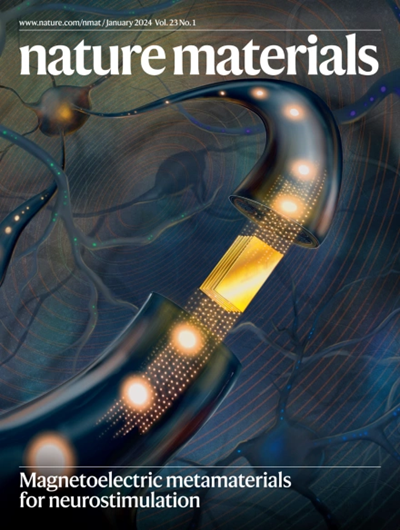All-electrical perpendicular switching of chiral antiferromagnetic order
IF 38.5
1区 材料科学
Q1 CHEMISTRY, PHYSICAL
引用次数: 0
Abstract
Antiferromagnets as active components in devices have been attracting attention due to their negligible stray field and ultrafast magnetic dynamics, which are promising for high-density and fast memory devices. Although the switching of antiferromagnetic (AFM) order by current-induced spin–orbit torque (SOT) has already been realized, field-free SOT-induced bidirectional switching of AFM order in perpendicular geometry has been elusive. Here we experimentally demonstrate field-free perpendicular switching of the magnetic octupole moct in chiral AFM Mn3Sn by combining in-plane and out-of-plane SOTs generated by two-dimensional van der Vaals WTe2. The out-of-plane SOT breaks the in-plane inversion symmetry and leads to deterministic bidirectional switching of moct in polycrystalline Mn3Sn even without a fixed perpendicular moct easy axis. The switching ratio reaches up to 80% compared to 20–30% in polycrystalline Mn3Sn and the critical current density is reduced by an order of magnitude to around 1 MA cm−2. Our work promotes the development of chiral AFM devices toward practical application. By introducing an unconventional spin–orbit torque, the authors demonstrate an all-electrical way to bidirectionally switch the perpendicular chiral antiferromagnetic order in Mn3Sn, promoting the application of antiferromagnetic spintronics.


手性反铁磁序的全电垂直开关
反铁磁体作为器件中的有源元件,由于其杂散场可忽略,磁动力学快,在高密度、快速存储器件中具有广阔的应用前景。虽然电流诱导的自旋轨道转矩(SOT)对反铁磁(AFM)有序的切换已经实现,但在垂直几何结构中由无场SOT诱导的反铁磁(AFM)有序的双向切换尚未实现。本文通过结合二维van der Vaals WTe2产生的面内和面外SOTs,实验证明了手性AFM Mn3Sn中磁性八极子运动的无场垂直开关。面外SOT打破了Mn3Sn多晶的面内反演对称性,即使没有固定的垂直运动易轴,也会导致运动的确定性双向切换。与多晶Mn3Sn的20-30%相比,开关率高达80%,临界电流密度降低了一个数量级,约为1 MA cm−2。我们的工作促进了手性AFM器件向实用化方向发展。
本文章由计算机程序翻译,如有差异,请以英文原文为准。
求助全文
约1分钟内获得全文
求助全文
来源期刊

Nature Materials
工程技术-材料科学:综合
CiteScore
62.20
自引率
0.70%
发文量
221
审稿时长
3.2 months
期刊介绍:
Nature Materials is a monthly multi-disciplinary journal aimed at bringing together cutting-edge research across the entire spectrum of materials science and engineering. It covers all applied and fundamental aspects of the synthesis/processing, structure/composition, properties, and performance of materials. The journal recognizes that materials research has an increasing impact on classical disciplines such as physics, chemistry, and biology.
Additionally, Nature Materials provides a forum for the development of a common identity among materials scientists and encourages interdisciplinary collaboration. It takes an integrated and balanced approach to all areas of materials research, fostering the exchange of ideas between scientists involved in different disciplines.
Nature Materials is an invaluable resource for scientists in academia and industry who are active in discovering and developing materials and materials-related concepts. It offers engaging and informative papers of exceptional significance and quality, with the aim of influencing the development of society in the future.
 求助内容:
求助内容: 应助结果提醒方式:
应助结果提醒方式:


